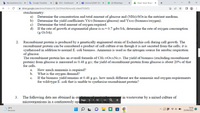
Basic Clinical Laboratory Techniques 6E
6th Edition
ISBN: 9781133893943
Author: ESTRIDGE
Publisher: Cengage
expand_more
expand_more
format_list_bulleted
Question
only number 2

Transcribed Image Text:b My Questions | bart X
* Google Translate
O SSO - Dashboard
Ti General ([SIAP-202 X
6 (6) WhatsApp
A Dasar-dasar Biopro X
+
A drive.google.com/drive/folders/10_DzC9YxnUNJnuvolJj-xOawSTUSkITz
stoichiometry:
a) Determine the concentration and total amount of glucose and (NH4)2SO4 in the nutrient medium.
b) Determine the yield coefficients Yx/s (biomass/glucose) and Yxo2 (biomass/oxygen).
c) Determine the total amount of oxygen required.
d) If the rate of growth at exponential phase is rx= 0.7 gdw/l-h, determine the rate of oxygen consumption
(g O2/l-h).
->
Recombinant protein is produced by a genetically engineered strain of Escherichia coli during cell growth. The
recombinant protein can be considered a product of cell culture even though it is not secreted from the cells; it is
synthesised in addition to normal E. coli biomass. Ammonia is used as the nitrogen source for aerobic respiration
of glucose.
The recombinant protein has an overall formula of CH1.55O0.31No.25. The yield of biomass (excluding recombinant
protein) from glucose is measured as 0.48 g g21; the yield of recombinant protein from glucose is about 20% of that
for cells.
2.
a. How much ammonia is required?
b. What is the oxygen demand?
If the biomass yield remains at 0.48 g g21, how much different are the ammonia and oxygen requirements
for wild-type E. coli that is unable to synthesise recombinant protein?
с.
3. The following data are obtained in oxidation of pesticides present in wastewater by a mixed culture of
5 1 10
Q +
microorganisms in a continuously operatng aeration tank
Page
26°C
19:56
LINE
Berawan
25/04/2022
..
>
Expert Solution
This question has been solved!
Explore an expertly crafted, step-by-step solution for a thorough understanding of key concepts.
Step by stepSolved in 2 steps

Knowledge Booster
Recommended textbooks for you
- Essentials of Pharmacology for Health ProfessionsNursingISBN:9781305441620Author:WOODROWPublisher:Cengage





Essentials of Pharmacology for Health Professions
Nursing
ISBN:9781305441620
Author:WOODROW
Publisher:Cengage
